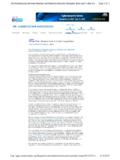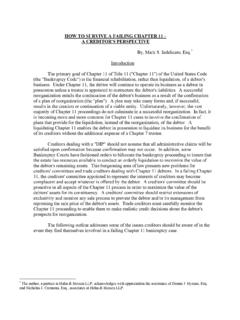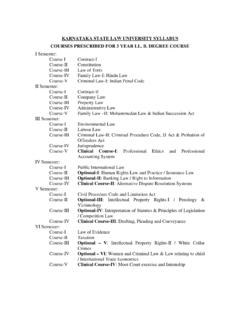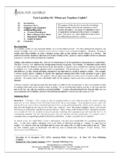Transcription of Business Torts Journal
1 1 Published in Business Torts Journal , Volume 18, Number 4, Summer 2011. 2011 by the American Bar Association. Reproduced with permission. All rights reserved. This information or any portion thereof may not be copied or disseminated in any form or by any means or stored in an electronic database or retrieval system without the express written consent of the American Bar any seasoned litigator is aware, there are many claims available to a company to address wrongful competition or to combat wrongful conduct by former employees.
2 Tortious interference claims are designed to tackle tortious interference with con-tracts, Business relationships, and prospective economic opportunities. These claims, how-ever, are intensely factual, and litigants that run afoul of the jurisdiction s pleading standards will find their claims forever generally recognize three universal members of the tortious interference family. The elements of each claim are similar but not identical, and some of these differences are in fact more substantive than first, and perhaps most common, member of this family is a claim for tortious inter-ference with an existing contract.
3 To sustain this claim, a plaintiff generally must allege the existence of a contract between the plaintiff and a third party, the defendant s knowledge of the contract, the defendant s intentional inducement of the third party to breach or otherwise render performance impossible, and damages to the plaintiff. See, , Israel v. Wood Dolson Co., 1 116, 120, 134 97, 99, 151 1, 5 (1956). The plaintiff must allege actual knowledge, as generally objective standards like implied knowledge or constructive knowledge are insufficient.
4 DBS Constr., Inc. v. New Equip. Leasing, Inc., 2011 Dist. LEXIS 32681, at *11 ( Ind. Mar. 28, 2011).Another member of the tortious interference family is a claim for tortious interference with Business relations. Perhaps the most obvious dis-tinction between this claim and its sister claim is that it is not necessary to establish the existence of any actual contract between the parties. Cole v. Homier Distrib. Co. Inc., 599 856, 861 (8th Cir. 2010) (applying Missouri law). Instead, the plaintiff must only show that the plaintiff had a Business relationship with a third party and the defendant knew of that relationship and intentionally interfered with it, the defendant acted solely out of malice or used improper or illegal means that amounted to a crime or inde-pendent tort , and the defendant s interference caused injury to the relationship with the third party.
5 Amaranth, LLC. v. J. P. Morgan Chase & Tortious Interference IssueVol. 18 Number 4 n Summer 2011 Committee ChairsLaura McLaughlinLogan College of ChiropracticChesterfield, MO(636) R. Berman Nutter McClennen & Fish, LLPB oston, MA(617) S. DavidsonWilliams Kastner Seattle, WA(206) EditorsGerardo R. BarriosBaker Donelson Mandeville, LA(985) J. BoyerHyland Levin, LLPM arlton, NJ(856) L. JohnsonMiller & Martin, PLLCN ashville, TN(615) PublishingJason HicksAssociate EditorSonya TaylorDesignerBusiness Torts Journal (ISSN 1549-2923) is published quarterly by the Committee on Business Torts Litigation, Section of Litiga-tion, American Bar Association, 321 N.
6 Clark Street, Chicago, IL 60654-7598. The views expressed within do not necessarily reflect the views of the American Bar Association, the Section of Litigation, or the Committee on Business Torts Litigation. 2011 American Bar AssociationAmerican Bar AssociationSection of LitigationCommittee onBusiness Torts LitigationBusiness Torts JournalMessage from the Chairs ..2 Message from the Editors ..3 Punitive Damages and IntentionalInterference with a Contractual Relationship ..4 Alternative Methods of Satisfying the Elements of Tortious Interference Claims.
7 9 Rule 26: Has the PendulumSwung Back to Efficient Expert Discovery? ..13 Tortious Interference with Expectation of Inheritance ..17 Inside This committees/businesstortsNavigating the Nuances of Tortious Interference ClaimsBy Zachary G. Newman and Anthony P. Ellis(Continued on page 20) Business Torts Journal SuMMER 201120 Published in Business Torts Journal , Volume 18, Number 4, Summer 2011. 2011 by the American Bar Association. Reproduced with permission. All rights reserved. This information or any portion thereof may not be copied or disseminated in any form or by any means or stored in an electronic database or retrieval system without the express written consent of the American Bar inTerference(Continued from page 1)Co.
8 , 71 40, 47, 888 489 ( App. Div. 2009). What exactly qualifies as a Business relationship is a factual issue, but courts have provided some guidance. For instance, one court has noted that a Business relationship is something less than a contractual right, something more than a mere hope [and] exists only when there is a reasonable probability that a contract will arise from the parties current dealings. Alvord-Polk, Inc. v. F. Schumacher & Co., 37 996, 1015 (3d Cir.)
9 1994) (quoting Thompson Coal Co. v. Pike Coal Co., 488 Pa. 198, 209, 412 466, 471 (Pa. 1979)).If no valid contract exists and the ability to establish a Business relationship is somewhat murky, some jurisdictions may nevertheless recognize a cause of action for tortious interference with an economic advantage. To establish this claim, a plaintiff generally must show an existing reasonable expectation or reasonable expectation of economic benefit or advantage; the defendant s knowledge of that expectancy; the defendant s wrongful, intentional interference with that expec-tancy; the reasonable probability that the claimant would have received the anticipated economic benefit in the absence of the defendant s interference.
10 And damages resulting from the defendant s interference. Lightning Lube, Inc. v. Witco Corp., 4 1153, 1167 (3d Cir. 1993).A valid Business expectancy is one in which there is a rea-sonable likelihood or probability that the expectancy will come to fruition; mere wishful thinking is not sufficient to support a claim. See, , First Public Corp. v. Parfet, 246 Mich. App. 182, 199, 631 785 (Mich. Ct. App. 2001), vacated in part on other grounds, 468 Mich. 101, 658 477 (Mich. 2003); Trepel v.








